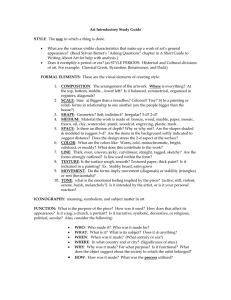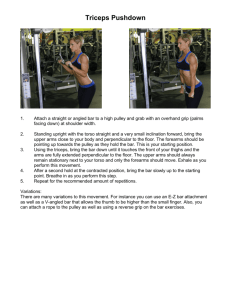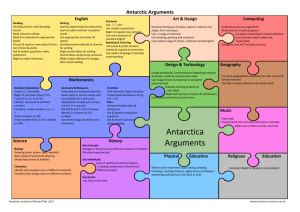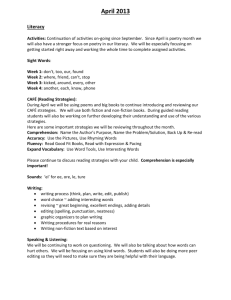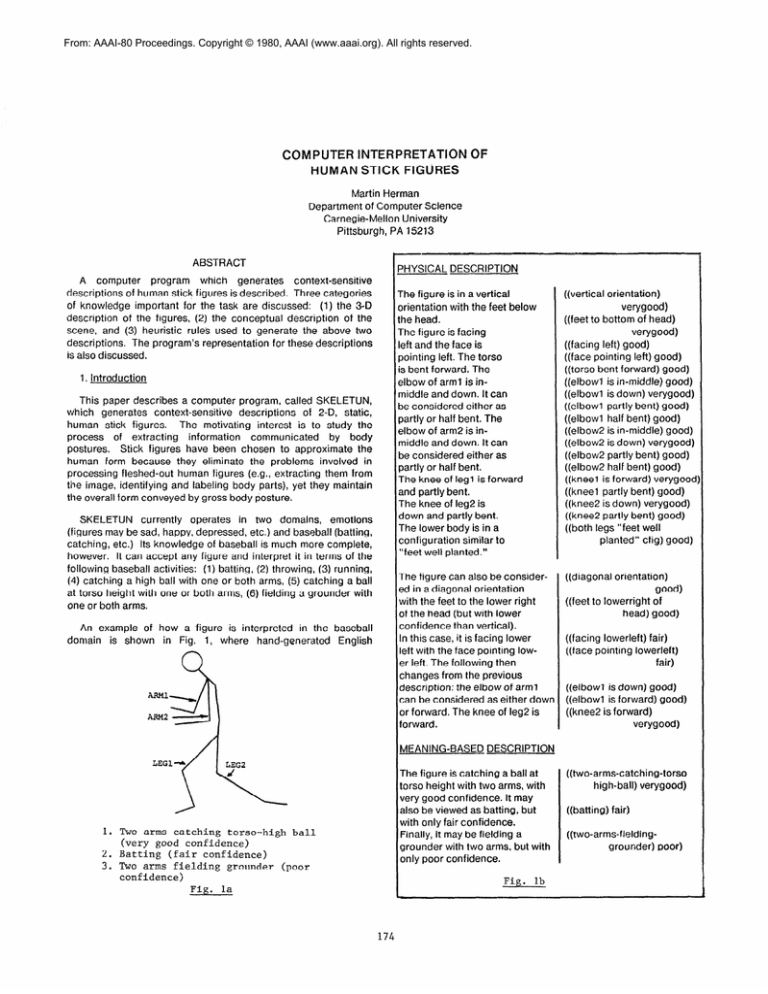
From: AAAI-80 Proceedings. Copyright © 1980, AAAI (www.aaai.org). All rights reserved.
COMPUTER
HUMAN
INTERPRETATION
STICK
OF
FIGURES
Martin Herman
Department of Computer Science
Carnegie-Mellon University
Pittsburgh, PA 15213
ABSTRACT
PHYSICAL DESCRIPTION
A computer
program
which
generates
context-sensitive
descriptions of human stick figures is described. Three categories
of knowledge important for the task are discussed:
(1) the 3-D
description of the figures, (2) the conceptual description of the
scene, and (3) heuristic rules used to generate the above two
descriptions.
The program’s representation for these descriptions
is also discussed.
1. Introduction
This paper describes a computer program, called SKELETUN,
which generates context-sensitive
descriptions
of 2-D, static,
human stick figures.
The motivating interest is to study the
process
of extracting
information
communicated
by body
postures.
Stick figures have been chosen to approximate the
human form because they eliminate the problems involved in
processing fleshed-out human figures (e.g., extracting them from
the image, identifying and labeling body parts), yet they maintain
the overall form conveyed by gross body posture.
SKELETUN currently
operates in two domains, emotions
(figures may be sad, happy, depressed, etc.) and baseball (batting,
catching, etc.) Its knowledge of baseball is much more complete,
however. It can accept any figure and interpret it in terms of the
following baseball activi ties: (1) batting, (2) throwing, (3) running,
(4) catching a high ball with one or both arms, (5) catching a ball
at torso height with one or both arms, (6) fielding a grounder with
one or both arms.
An example of how a figure is interpreted
in the baseball
domain is shown in Fig. 1, where hand-generated
English
Q
The figure is in a vertical
orientation with the feet below
the head.
The figure is facing
left and the face is
pointing left. The torso
is bent forward. The
elbow of arm1 is inmiddle and down. It can
be considered either as
partly or half bent. The
elbow of arm2 is inmiddle and down. It can
be considered either as
partly or half bent.
The knee of leg1 is forward
and partly bent.
The knee of leg2 is
down and partly bent.
The lower body is in a
configuration similar to
“feet well planted.”
((vertical orientation)
verygood)
((feet to bottom of head)
verygood)
((facing left) good)
((face pointing left) good)
((torso bent forward) good)
((elbow1 is in-middle) good)
((elbow1 is down) verygood)
((elbow1 partly bent) good)
((elbow1 half bent) good)
((elbow2 is in-middle) good)
((elbow2 is down) verygood)
((elbow2 partly bent) good)
((elbow2 half bent) good)
((kneel is forward) verygooc
((kneel partly bent) good)
((knee2 is down) verygood)
((knee2 partly bent) good)
((both legs “feet well
planted” cfig) good)
The figure can also be considered in a diagonal orientation
with the feet to the lower right
of the head (but with lower
confidence than vertical).
In this case, it is facing lower
left with the face pointing lower left, The following then
changes from the previous
description: the elbow of arm1
can be considered as either down
or forward. The knee of leg2 is
forward.
((diagonal orientation)
MEANING-BASED
Fig.
174
((facing lowerleft) fair)
((face pointing lowerleft)
fair)
((elbow1 is down) good)
((elbow1 is forward) good)
((knee2 is forward)
verygood)
DESCRIPTION
The figure is catching a ball at
torso height with two arms, with
very good confidence. It may
also be viewed as batting, but
with only fair confidence.
Finally, it may be fielding a
grounder with two arms, but with
only poor confidence.
1. Two arms catching torso-high ball
(very good confidence)
2. Batting (fair confidence)
3. Two arms fielding grounder (poor
confidence)
Fig. la
good)
((feet to lowerright of
head) good)
lb
((two-arms-catching-torso
high-ball) verygood)
((batting) fair)
((two-arms-fieldinggrounder)
poor)
“conceptual”
scene.
descripticns are shown alongside the computer-generated
output.
SKELETUN’s primary purpose is to generate a description of what
is communicated
by body posture - the “meaning-based”
description.
In the process of generating this description, it also
provides the 3-D configuration
of the figures - the physical
descripticn.
Briefly, the notation in the example is as follows. If a
figure is viewed from the front or back, each elbow or knee can be
either QI& from the torso, b to the torso (i.e., crossing the torso) or
in-middle (i.e., along the same line as the torso). If the figure is
viewed from the side, each elbow or knee can be either u,
forward.
backward, or back-uo (i.e., backward and up).
All
assertions in the dessriptlons have discrete confidence values.
extracted
from
the
@Human Phvsical Structure - information dealing with
the various
parts of the stick figure body and
components of these parts.
Q -Inference Rules - heuristic rules used to obtain the
3-D configuration
of the figures from the 2-D scene,
and to determine what the figures are doing based on
the 2-D and 3-D configurations of the limbs.
The following sections will further discuss the 2nd, 3rd, and 5th
categories.
More details than can be provided here on all of the
categories may be found in [7].
3. Phvsical Soace Descriotion
This paper gives an overview of the types of information
conveyed by gross body postures, SKELETUN’s representation for
this information, and some inference rules used to generate this
information from 2-D scenes. See [7] for details.
In order to infer what is being communicated by a figure’s body
posture, there must be knowledge of at least part of its 3-D
configuration,
for it is a 2-D figure interpreted as being in 3-D
space to which meaning is applied.
1.l Backaround
It is convenient to have two different levels of physical space
descriptions.
One, called the lower level phvsical
soace
descrintion, deals with the 3-D positions of the individual body
parts.
The second, called the hiaher level phvsical soace
clescriotion, deals with frequently occurring positions of groups of
body parts. Only the first description will be discussed in this
paper (see [7] for more details).
This work views vision as a medium of communication,
recognizing that an important goal of the visual process is to
provide the viewer with a “meaning” description of the external
world.
Most scene analysis systems are primarily concerned
with
identifying objects and other entities in a scene and specifying the
spatial configuration of these entities [6, 3, 8, 41. Given a scene
with human figures, such systems would tend to identify the
individual figures, their body parts, and other objects, and then
specify the spatial relationships
of these entities [9, 10, 11.
SKELETUN goes one step further in the interpretation process. It
tries to determine what the people are doing, and perhaps why
they are doing it.
Although a figure’s 3-D configuration may be represented many
ways, the representation to be described next was chosen for two
reasons:
1. Its purpose is to describe the figure in a manner useful
for generating meaning-based interpretations.
If the
resolution is too fine (as in [lo]), it will contain much
information not significant for the task, thus burdening
the system. If the resolution is too coarse, it will not
contain enough information to perform the task.
Although some previous work has taken the point of view of
vision as communication [2, 14, 151, their primary purpose was to
analyze and describe motion scenes, rather than to study how
body posture conveys information.
2. It is convenient
figure’s
3-D
understood by
makes this kind
cateqories
Five categories of knowledge have been identified as important
in the process of generating descriptions of 2-D scenes of stick
figures.
The first three represent important levels at which the
scene should be described.
3.1 Descriotions
for SKELETUN to be able to express a
configuration
in a manner
easily
humans.
The current representation
of information explicit.
relative to the torso
The 3-D descriptions
in SKELETUN are object-centered,
as
opposed to viewer-centered.
That is, locations and directions of
parts of the figure are indicated with respect to the figure, rather
than the viewer. A viewer-centered description depends not only
on the figure being described, but also on its orientation.
An
object-centered
description, however, depends only on the figure
being described, resulting in a smaller set of possible descriptions
o Two-Dimensional Descriotion - a low-level description
involving the direction of each body part (each is a
straight line segment), the angle of each joint (in the
2-D plane), and body parts which overlap (required for
establishing touching relationships).
e Phvsical Soace Descriotion - a 3-D description
physical configurations of the figures.
is
The next two categories involve knowledge used to extract the
physical
and meaning
space
descriptions
from the 2-D
description.
The input to SKELETUN is a hand-encoding
of the x, y
coordtnates of the end points of the line segments of each figure,
plus the center of the circle representing the head. SKELETUN
assumes that all figures are complete and valid, and that no
objects other than figures are in the scene (a scene may have two
figures).
2. Knowledqe
information)
[111.
of the
Accordingly,
the positions of the upper arms and legs are
represented relative to the torso, and the shape of the torso is
represented
relative to the overall orientation
of the figure.
SKELETUN uses the predicates OUT, IN-MIDDLE, and IN to
describe the position of each elbow or knee as viewed from the
o Meanina Soace Descriotion - a description in terms of
the information communicated
by the figures (e.g.,
running, fighting, crying). The concepts here are said
to be in Meaning
Space since “meaning”
(or
175
front, and UP, FORWARD, DOWN, BACKWARD, and BACK-UP to
describe the positions as viewed from the side. These predicates
are adequate to completely specify (within the resolution of the
representation) the 3-D position of any elbow or knee (i.e., upper
arm or leg). SKELETUN uses the predicates BENT-FORWARD
and BENT-BACKWARD to specify how the torso joints are bent.
3.2 Hierarchv of obiect-centered
c&.criotions
The positions of the lower arms and legs are represented
relative to the upper arms and legs, respectively.
Note that a
representation of the lower limbs relative to the torso would result
in a much larger set of possible descriptions than a representation
relative to the upper limbs, since a different description of the
lower limb would be required for each position of the upper limb
relative to the torso, even if the position of the lower relative to the
upper limb were to remain constant.
Since similar arguments apply to describing positions of other
body parts, such as hands, fingers, feet, etc., we conclude that
each body part should be represented relative to the part it is
connected to, resulting in a hierarchy of descriptions [lo].
SKELETUN represents the positions of the lower arms and legs
by specifying the 3-D angle of the elbow and knee joints. The
predicates used are PARTLY-BENT, HALF-BENT, FULLY-BENT,
and NOT- BENT.
3.3 Orientation
relative to viewer
---
Thus far, all descriptions have been relative to parts of the
figure. The whole figure must also be placed in 3-D space, relative
to the viewer. The predicate ORIENTATION describes the overall
orientation of the figure either as vertical, horizontal, or diagonal.
Given
one
of
these
orientations,
the
predicate
DIR-OF-FEET-TO-HEAD specifies the direction of the feet relative
to
the
head.
Finally,
the
predicates
DIR-FACING
and
DIR-FACE-IS-POINTING
specify the direction the figure is facing
and the direction the face is pointing.
Cc)
(5)
(a)
Three
upright stick
Fig. 2
figures.
concern is not to extract all the details of each concept. Instead,
they are represented as labels (RUNNING, CRYING,WALKING,
etc.), where the meaning is represented implicitly in terms of the
inference rules which may assert the concept and those which
may use the concept to assert other concepts.
This is because
SKELETUN’s concern is to discover and make use of relationships
among concepts [12].
Two important classes cf information that can be extracted
from the body postures of stick figures deal with (1) the physical
states of the figures (running, walking, throwing, standing, etc.)
and (2) the mental or emotional states of the figures (weeping,
happy, thinking, etc.).
Two types of physical states can be distinguished, active and
passive. Active physical states involve activities requiring motion,
such as running, dancing, or hitting.
Passive physical states
involve no motion; examples are standing, pointing, and watching.
Mental-emotional
states
can also be divided
into two
categories,
negative and positive.
Negative states generally
involve feelings or tendencies
such as painful excitement,
tension,
loneliness,
discomfort,
destruction,
dullness,
incompetence,
dissatisfaction,
and helplessness
(e.g., anger,
sadness, apathy, panic, hate, grief, disgust).
Positive states
generally involve feelings or tendencies such as vitality, empathy
toward others, comfort, and self-confidence
(e.g., cheerfulness,
enjoyment, happiness, hope, love, pride) [5]. The negative and
positive states can each be further subdivided into passive and
active. These will not be pursued here (see [7]).
3.4 Phvsical space inference rules
These rules generate the physical space description.
They are
domain-independent,
for they
depend
only
on the 3-D
configuration
of the figures. As an example of the knowledge in
these rules, consider how SKELETUN determines the overall
orientation of the figure. A figure is horizontal if both feet are east
or west of the head (as in lying). A figure is diagonal if both feet
are southeast, southwest, northeast, or northwest of the head.
There are two types of vertical orientations,
upright and
upside-down.
(SKELETUN currently cannot handle upside-down
figures.) Fig. 2 shows three extremes of upright figures. In Fig. 2a,
both feet are south of the head. In Fig. 2b, both feet are not south
of the head; the point midway between the feet is south of the
head. In Fig. 2c, the midway point is not south of the head; only
one foot is south of the head. Rules which determine whether a
figure is upright must examine these three types of cases. For
more details on these and other inference rules, see [7].
4.2 Meaninq soace inference rules
These rules generate the meaning space description.
They
since most meaning-space
tend to be domain-dependent,
concepts are applicable only in limited domains. As an example of
the knowledge
in these rules, consider
how SKELETUN
determines that a figure is fielding a grounder (assuming that the
domain is baseball). (See Fig. 3 for exampies.) First, one or both
arms must be in a “fielding grounder” configuration (a higher level
physical configuration
described in [7]). In addition, the lower
body should be in a configuration
similar to “kneeling on one
knee” (Fig. 3b), “kneeling on both knees”, “feet well planted”
(Fig. 3c), or “crouching”
(Fig. 3d) [7] and the figure should be
If the figure’s orientation is diagonal, its lower body
vertical.
should be in a “crouching”
configuration
and it must be facing
Finally, if both arms are in a
either lower-left or lower-right.
4. Meaninq soace descriotion
4.1 Reoresentation
Meaning space concepts in SKELETUN are not represented
explicitly in terms of simpler concepts and relationships between
them (as in Conceptual
Dependency
[13]), since SKELETUN’s
176
“fielding grounder” configuration
and the figure is running, it is
also fielding a grounder, i.e., running after a ground ball (Fig. 3a).
7.
Herman, M. Understanding body postures of human stick
figures. Tech. Rept. 836, Computer Science Center, University of
Maryland, College Park, MD, 1979.
Acknowledoement
This research is part of the author’s Ph.D. thesis
University of Maryland, under the guidance of Chuck
Azriel Rosenfeld. The support of the National Science
under Grant MCS-76-23763 is gratefully acknowledged,
Shneier for valuable comments, and Ernie Harris
preparing this paper.
Levine, M. D. A knowledge-based
computer vision system.
8.
Computer
Vision Systems, Hanson and Riseman, Ed.,Academic
done at the
Rieger and
Foundation
as is Mike
for help in
In
Press, 1978.
9.
Marr, D., and Nishihara, H. K. Spatial disposition of axes in a
generalized cylinder representation of objects that do not
encompass the viewer. AIM 341, MIT, 1975.
Marr, D., and Nishihara, H. K. Representation and
10.
recognition of the spatial organization of three-dimensional
shapes. AIM 416, MIT, 1977.
11.
Nishihara, H. K. Intensity, visible surface, and volumetric
representations.
Workshop
on the Representation
of
Three-Dimensional
Oblects, Univ. of Pennsylvania, Philadelphia,
PA, 1979.
12.
Rieger, C. Five aspects of a full-scale story comprehension
model. In Associative
Networks:
The Representation
and Use of
Know/edge
in Computers,
N. Findler, Ed.,Academic Press, 1978.
>
(a)
(b)
13.
Schank, R. C. Identification of conceptualizations
underlying natural language. In Computer
Models of Thought
and
Language,
Schank and Colby, Ed.,W. H. Freeman and Co., 1973.
14.
Tsuji, S., Morizono, A., and Kuroda, S. Understanding a
simple cartoon film by a computer vision system. Proc. HJCAI,
Cambridge, MA, 1977.
15.
Weir, S. The perception of motion: actions, motives, and
feelings. Progress in Perception Research Report No. 13, Dept. of
Artificial Intelligence, University of Edinburgh, 1975.
Cd)
Each
figure
is fielding
Fig. 3
a grounder.
References
1.
Adler, M. Computer interpretation
SIJCAI, Cambridge, MA, 1977.
of Peanuts cartoons.
Proc.
2.
Badler, N. I. Temporal scene analysis: conceptual
descriptions of object movements. Tech. Rept. 80, Dept. of
Computer Science, University of Toronto, 1975.
3.
Bajcsy, R., and Joshi, A. K. A partially ordered world model
and natural outdoor scenes. In Computer
Vision Systems, Hanson
and Riseman, Ed.,Academic Press, 1978.
4.
Barrow, H. G., and Tenenbaum, J. M. MSYS: A system for
reasoning about scenes. Artificial Intelligence Center Technical
Note 121, Stanford Research Institute, 1976.
Davitz, J. R. The Language
1969.
5.
of Emotion.
Academic Press,
6.
Hanson, A. R., and Riseman, E. M. VISIONS: a computer
system for interpreting scenes. In Computer
Vision Systems,
Hanson and Riseman, Ed.,Academic Press, 1978.
177

